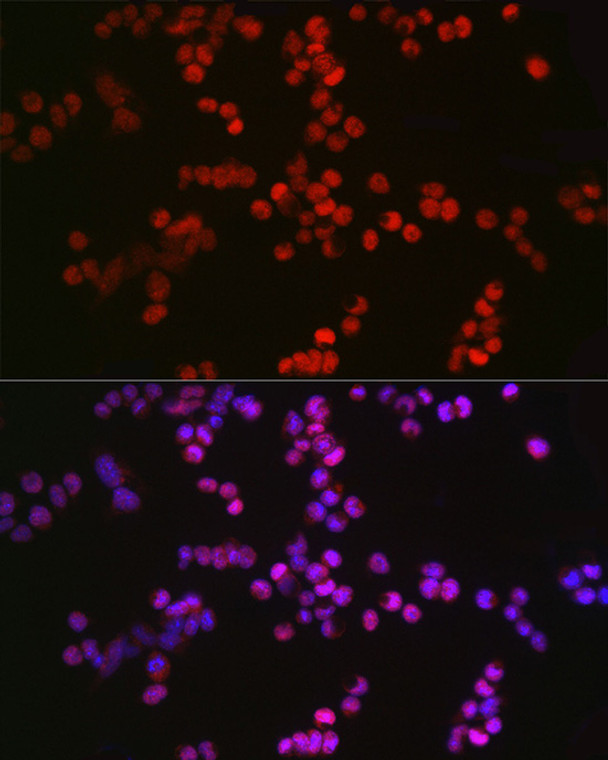| Host: |
Rabbit |
| Applications: |
WB/IF |
| Reactivity: |
Human/Mouse/Rat |
| Note: |
STRICTLY FOR FURTHER SCIENTIFIC RESEARCH USE ONLY (RUO). MUST NOT TO BE USED IN DIAGNOSTIC OR THERAPEUTIC APPLICATIONS. |
| Short Description: |
Rabbit polyclonal antibody anti-TET2 (288-448) is suitable for use in Western Blot and Immunofluorescence research applications. |
| Clonality: |
Polyclonal |
| Conjugation: |
Unconjugated |
| Isotype: |
IgG |
| Formulation: |
PBS with 0.05% Proclin300, 50% Glycerol, pH7.3. |
| Purification: |
Affinity purification |
| Dilution Range: |
WB 1:500-1:1000IF/ICC 1:50-1:200 |
| Storage Instruction: |
Store at-20°C for up to 1 year from the date of receipt, and avoid repeat freeze-thaw cycles. |
| Gene Symbol: |
Tet2 |
| Gene ID: |
214133 |
| Uniprot ID: |
TET2_MOUSE |
| Immunogen Region: |
288-448 |
| Immunogen: |
Recombinant fusion protein containing a sequence corresponding to amino acids 288-448 of mouse TET2 (NP_001035490.2). |
| Immunogen Sequence: |
NASKPAIVPGTCPFQKAEHQ QKSALDIGPSRAENKTIQGS MELFAEEYYPSSDRNLQASH GSSEQYSKQKETNGAYFRQS SKFPKDSISPTTVTPPSQSL LAPRLVLQPPLEGKGALNDV ALEEHHDYPNRSNRTLLREG KIDHQPKTSSSQSLNPSVHT P |
| Tissue Specificity | Expressed in the brain, kidney, heart, lung, muscle and stomach. Expressed in germinal vesicle (GV) stage and MII-stage oocytes and in early embryos. Present in embryonic stem cells (ES cells). |
| Post Translational Modifications | May be glycosylated. It is unclear whether interaction with OGT leads to GlcNAcylation. According to a report, it is GlcNAcylated by OGT. In contrast, another group reports no GlcNAcylation by OGT in human ortholog. Monoubiquitinated at Lys-1212 by the DCX (DDB1-CUL4-X-box) E3 ubiquitin-protein ligase complex called CRL4(VprBP) or CUL4A-RBX1-DDB1-DCAF1/VPRBP complex.this modification promotes binding to DNA. |
| Function | Dioxygenase that catalyzes the conversion of the modified genomic base 5-methylcytosine (5mC) into 5-hydroxymethylcytosine (5hmC) and plays a key role in active DNA demethylation. Has a preference for 5-hydroxymethylcytosine in CpG motifs. Also mediates subsequent conversion of 5hmC into 5-formylcytosine (5fC), and conversion of 5fC to 5-carboxylcytosine (5caC). Conversion of 5mC into 5hmC, 5fC and 5caC probably constitutes the first step in cytosine demethylation. Methylation at the C5 position of cytosine bases is an epigenetic modification of the mammalian genome which plays an important role in transcriptional regulation. In addition to its role in DNA demethylation, also involved in the recruitment of the O-GlcNAc transferase OGT to CpG-rich transcription start sites of active genes, thereby promoting histone H2B GlcNAcylation by OGT. |
| Protein Name | Methylcytosine Dioxygenase Tet2Protein Ayu17-449 |
| Cellular Localisation | NucleusChromosomeLocalization To Chromatin Depends Upon Monoubiquitination At Lys-1212 |
| Alternative Antibody Names | Anti-Methylcytosine Dioxygenase Tet2 antibodyAnti-Protein Ayu17-449 antibodyAnti-Tet2 antibodyAnti-Kiaa1546 antibody |
Information sourced from Uniprot.org
12 months for antibodies. 6 months for ELISA Kits. Please see website T&Cs for further guidance









